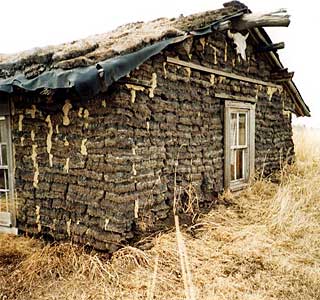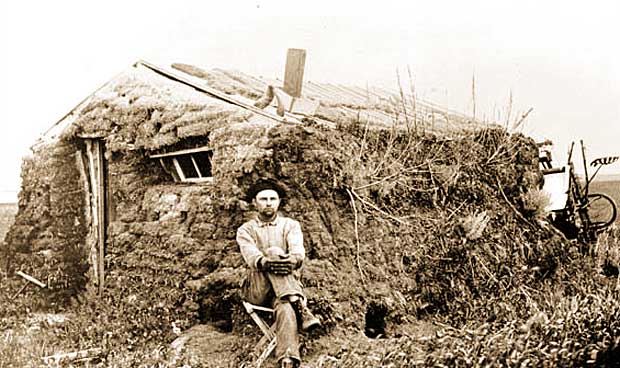History of Sod Houses
This is a short history of sod houses. Sod houses were first
built when homesteaders began settling towards the western United
States. Starting in 1862, people could pay a fee to homestead
on a parcel of land, and after five years of work, the land would
be theirs.
 Sod House
Sod House |
|
But settlers were traveling west before the railroads, and had
no way to get large quantities of building materials to their
land. They usually had to build a house within six months of claiming
the land. By the year 1900, more than 600,000 claims for land
had been filed.
Going through the 1870's and from then on, you could see both
inadequate and adequate sod houses. The sturdiness of the building
depended on the skill of the people who made it and the time and
effort that were expended. Some more extravagant homes were built
as two stories, and it took a lot of skill to be sure that they
would stand. One rather shoddy "soddy" was still standing
in 1967, when it was vacant and torn down.
The Roots of the Sod House ...
Grasses with dense root systems worked best for sod houses, but
the pieces of sod were very difficult to cut into bricks. By the
middle of the 1880's, grasshopper and breaking plows were developed,
and they greatly simplified the cutting of sod for use in homes.
The average house of the day was only about 16 x 20 feet, and
took roughly 3000 bricks of sod to build.
Some settlers started their homes by doing dugouts, or small spaces
that were dug into the sides of hills. These offered them some
protection from the wild weather of the prairie. They worked better
than tents, especially against the wind, and they were drier and
warmer than the tents of the day. Often, settlers would make a
dugout and then build their sod home in front of it, and use the
original dugout as a separate room.

There were no motorized tractors available to the average farmers
in the 1800's, so they used horses, oxen or mules to cut the roots
in the sod they would use as bricks. If they didn't use sod bricks
the same day they were cut, they often crumbled or cracked. It
was common practice to cut the sod from the ground that would
become the floor of the house. This would give them a flat area
to build on, and removing the grasses made the houses safer from
prairie fires.
Roofs of sod houses were dangerous to build, and difficult to
construct. Not having access to slate tiles or wood shingles,
the farmers used the natural materials that were readily available.
They used cedar poles to hold up tied bundles of brush, with sod,
grass and mud added. The roofs dropped water or dirt into the
house at times, and many farmers hung sheets made from muslin
under the roofs, to keep things from falling into the rooms.
Conclusion
Some people loathed living in sod houses, and other people bloomed
in them. The home life would certainly be harder, by the standards
of today. Dirt floors were common, and wood was sometimes used
for floors, as well. Some of the settlers would look back with
fondness at the years they spend in their "soddies",
and some of the houses stood well into the 1900's.
|

